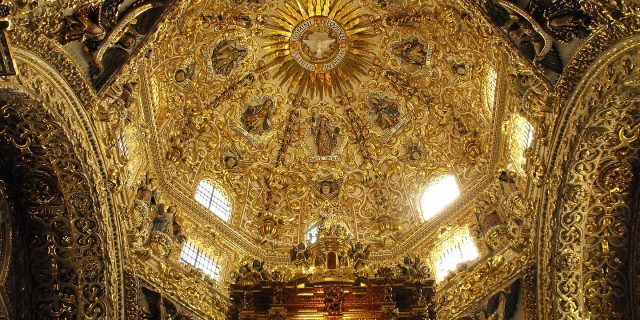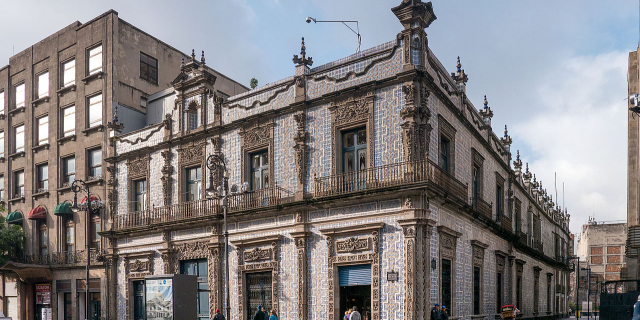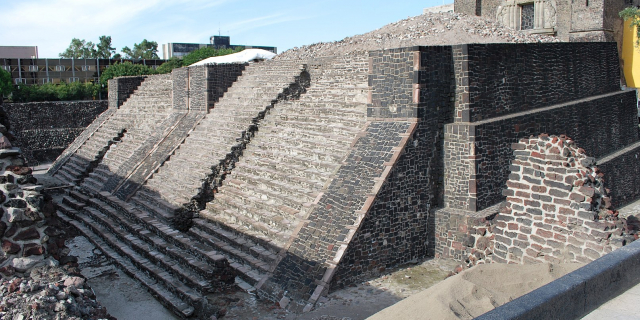Popocatépetl (UK: POP-ə-KAT-ə-pet-əl, -kat-ə-PET-əl, US: POHP-, Spanish: [popokaˈtepetl] ; Nahuatl languages: Popōcatepētl [popoːkaˈtepeːt͡ɬ] ) is an active stratovolcano located in the states of Puebla, Morelos, and Mexico in central Mexico. It lies in the eastern half of the Trans-Mexican volcanic belt. At 5,393 m (17,694 ft) it is the second highest peak in Mexico, after Citlaltépetl (Pico de Orizaba) at 5,636 m (18,491 ft).
It is linked to the twin volcano of Iztaccihuatl to the north by the high saddle known as the "Paso de Cortés". Izta-Popo Zoquiapan National Park, wherein the two volcanoes are located, is named after them.
Pop...Read more
Popocatépetl (UK: POP-ə-KAT-ə-pet-əl, -kat-ə-PET-əl, US: POHP-, Spanish: [popokaˈtepetl] ; Nahuatl languages: Popōcatepētl [popoːkaˈtepeːt͡ɬ] ) is an active stratovolcano located in the states of Puebla, Morelos, and Mexico in central Mexico. It lies in the eastern half of the Trans-Mexican volcanic belt. At 5,393 m (17,694 ft) it is the second highest peak in Mexico, after Citlaltépetl (Pico de Orizaba) at 5,636 m (18,491 ft).
It is linked to the twin volcano of Iztaccihuatl to the north by the high saddle known as the "Paso de Cortés". Izta-Popo Zoquiapan National Park, wherein the two volcanoes are located, is named after them.
Popocatépetl is 70 km (43 mi) southeast of Mexico City, from where it can be seen regularly, depending on atmospheric conditions. Until recently, the volcano was one of three tall peaks in Mexico to contain glaciers, the others being Iztaccihuatl and Pico de Orizaba. In the 1990s, the glaciers such as Glaciar Norte (North Glacier) greatly decreased in size, partly due to warmer temperatures but largely due to increased volcanic activity. By early 2001, Popocatépetl's glaciers were gone; ice remained on the volcano, but no longer displayed the characteristic features of glaciers such as crevasses.
Lava erupting from Popocatépetl has historically been predominantly andesitic, but it has also erupted large volumes of dacite. Magma produced in the current cycle of activity tends to be a mixture of the two with the andesites being rich in magnesium.
The geological history of Popocatépetl began with the formation of the ancestral volcano Nexpayantla. About 200,000 years ago, Nexpayantla collapsed in an eruption, leaving a caldera, in which the next volcano, known as El Fraile, began to form. Another eruption about 50,000 years ago caused that to collapse, and Popocatépetl rose from that. Around 23,000 years ago, a lateral eruption (believed to be larger than the 1980 eruption of Mount St. Helens) destroyed the volcano's ancient cone and created an avalanche that reached up to 70 kilometres (43 mi) from the summit. The debris field from that is one of four around the volcano, and it is also the youngest.[1]
Three Plinian eruptions are known to have taken place: 3,000 years ago (3195–2830 BC), 2,150 years ago (800–215 BC), and 1,100 years ago (likely 823 AD).[1] The latter two buried the nearby village of Tetimpa, preserving evidence of preclassical culture.[2]
The first recorded European ascent of the volcano was made by an expedition led by Diego de Ordaz in 1519.[3]: 182 The early-16th-century monasteries on the slopes of the mountain are a World Heritage Site.
Eruptions

Popocatépetl is one of the most active volcanoes in Mexico and the most famous,[4] having had more than 15 major eruptions since the arrival of the Spanish in 1519.
Timeline Mid-to late first century: A violent VEI-6 eruption may have caused the large migrations that settled Teotihuacan, according to DNA analysis of teeth and bones.[5] Eruptions were observed in 1363, 1509, 1512, 1519–1528, 1530, 1539, 1540, 1548, 1562–1570, 1571, 1592, 1642, 1663, 1664, 1665, 1697, 1720, 1802, 1919, 1923, 1925, and 1933.[6] January and February 1947: There were brief explosions, expelling steam and ash.[7] 21 December 1994: The volcano spewed gas and ash, which was carried as far as 25 km (16 mi) away by prevailing winds. The activity prompted the evacuation of nearby towns and scientists to begin monitoring for an eruption.[8] December 2000: Tens of thousands of people were evacuated by the government, based on the warnings of scientists. Then the volcano made its largest display in 1,200 years.[9][10][11][12] 25 December 2005: The volcano's crater produced an explosion which ejected a large column of smoke and ash about 3 km (9,800 ft) into the atmosphere and expulsion of lava.[citation needed] January and February 2012: Scientists observed increased volcanic activity at Popocatépetl. On January 25, an ash explosion occurred on the mountain, causing much dust and ash to contaminate the atmosphere around it.[8] 15 April 2012: There were reports of superheated rock fragments being hurled into the air by the volcano. Ash and water vapor plumes were reported 15 times over 24 hours.[13] 8 May 2013: at 7:28 p.m. local time, Popocatépetl erupted again with a high amplitude tremor that lasted and was recorded for 3.5 hours. It began with plumes of ash that rose 3 km (9,800 ft) into the air and began drifting west at first, but later began to drift east-southeast, covering areas of the villages of San Juan Tianguismanalco, San Pedro Benito Juárez and Puebla in smoke and ash. Explosions from the volcano subsequently ejected fragments of fiery volcanic rock to distances of 700 m (2,300 ft) from the crater.[14][15] July 4, 2013: Due to several eruptions of steam and ash for at least 24 hours, at least six U.S. airlines canceled more than 40 flights into and out of Mexico City International Airport and Toluca International Airport.[16] 27 August–September 2014: CENAPRED reported explosions, accompanied by steam-and-gas emissions with minor ash and ash plumes that rose 800–3,000 m (2,600–9,800 ft) above Popocatépetl's crater and drifted west, southwest, and west-southwest. On most nights incandescence was observed, increasing during times with larger emissions.[17] 29 and 31 August 2014: The Washington Volcanic Ash Advisory Center (VAAC) reported discrete ash emissions.[6] 7 January 2015: CENAPRED reported that ash from recent explosions coated the snow on the volcano's upper slopes.[18] 28 March 2016: An ash column 2,000 m (6,600 ft) high was released, prompting the establishment of a 12-kilometre (7.5 mi) "security ring" around the summit.[19] 3 April 2016: Popocatépetl erupted, spewing lava, ash and rock.[20] August 2016: Eruptions continued, with four discrete blasts on August 17.[21] 10 November 2017: at 7:25 local time, an eruption occurred.[6] 15 December 2018: at 18:57 local time, the volcano spewed lava, ash and rocks.[22] 22 January 2019: at 21:06 local time, the volcano spewed ash up to 3 km (9,800 ft) high and incandescent fragments 2 km (1.2 mi) away.[23] 19 March 2019: at 21:38 local time, fragments of the dome shot within 1.6–2.4-kilometre (1–1+1⁄2 mi) radius.[24] Due to continuing activity, on March 28 2019, based on the analysis of the available information, the Scientific Advisory Committee of the Popocatépetl volcano recommended changing the phase of the Yellow Volcanic Warning Light Phase 2 to Yellow Phase 3, which is a preventive measure against the observed changes.[25] June 3, 2019: Popocatépetl fired an ash column to approximately 11 km (37,000 ft) above sea level.[26] June 18, 2019: Popocatépetl spewed ash clouds to 8.5 km (28,000 ft).[27] June 24, 2019 Popocatépetl erupted once more, sending an ash cloud some kilometres (thousands of feet) into the air.[28] July 18, 2019: Popocatépetl erupted three times, sending ash 1.5 km (4,900 ft) into the air each time.[29] July 20, 2019: volcanic ash was reported in Xochimilco after a morning eruption.[30] October 2019: the volcano erupted multiple times in one night.[31] November 2019: an eruption forced a KLM flight from Amsterdam to Mexico City to turn back.[32] January 9, 2020: Popocatépetl expelled lava and rock and sent ash clouds to 6.1 km (20,000 ft).[33] January 27, 2020: Popocatépetl erupted in a nighttime display of rock and ash.[34][35] February 5, 2020: Popocatépetl had a moderate explosion producing an ash plume that went up 1.5 km (0.93 mi). More explosions on February 15, 18, and 22 sent ash plumes rising from 400–1,200 m (1,300–3,900 ft).[36] December 19, 2022: Popocatépetl emitted materials up to one kilometer (0.62 mi) high[37] May 19, 2023: Popocatépetl emitted some ash causing the closure of schools in 11 nearby towns[38] and two days later on May 21, the alert level in Mexico City was raised to Yellow Phase 3 as incandescent fragments were observed and the airports in Mexico City and Puebla were temporarily shut down.[39] February 27-28, 2024: Popocatépetl erupted 13 times within 24 hours, causing the cancellation of 22 flights at Mexico City and Puebla International Airports.[40]































Add new comment